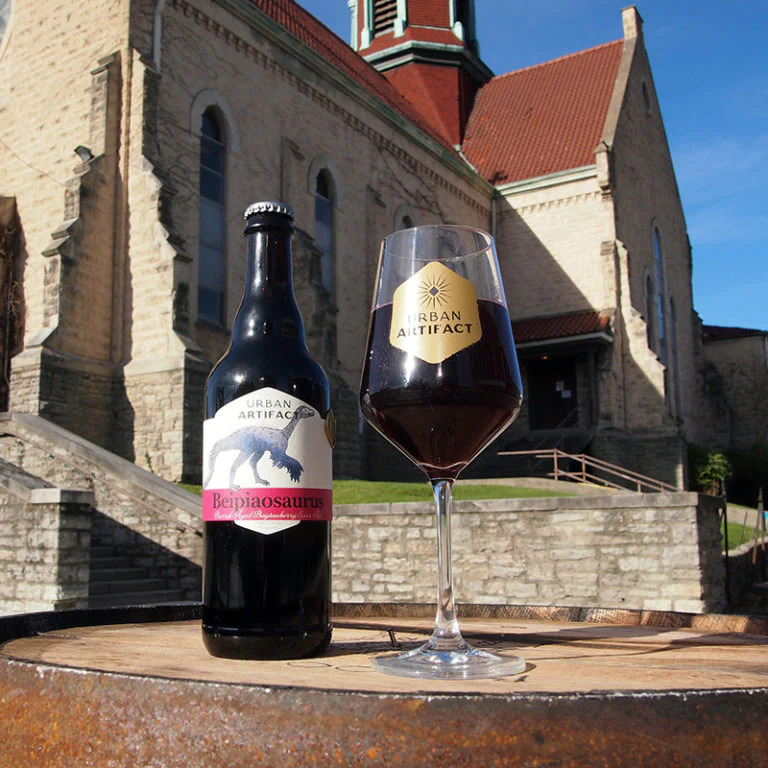
Jul 06, 2022
The News
The Story
Urban Artifact is a Cincinnati, Ohio brewery dedicated to producing world-class Fruit Tarts made exclusively with real fruit. We operate in the historic St. Patrick's Church in Cincinnati's Northside neighborhood; offering a taproom, full bar, live music venue, and event space.
Everything we do is inspired by our culture, community, and the microscopic natural world around us; all for one purpose — to reward the curious.
What is a “Midwest Fruit Tart” Ale?
Let’s cut to the chase before the digression begins. Simply put, the Midwest Fruit Tart Ale is a style defined by a few key factors: intense real fruit flavor and aroma which is balanced by a moderate to high clean lactic acidity, moderate to high level of alcohol, and a malt profile designed to enhance and support the profoundly decadent nature of these beers. Light funk from wild yeast or wood fermentation characteristics is acceptable but not present in most examples. Beers falling into this category may be considered as liquid embodiments of a Fruit Tart, with balance, explicit articulation of genuine fruit flavors and indulgence apparent upon even casual assessment.
So, how do you brew this style of beer? Well, like anything, techniques are going to vary from brewer to brewer, but here are a few good tips for you that will help to create world class Midwestern Fruit Tart beers:
• Use real fruit. Whole fruit single strength purees are a great way for the brewer to save on the labor required to process fresh whole fruit. If you are planning on using whole fruit, frozen (IQF) is a great alternative to fresh as the fruit is picked at peak freshness and frozen at the farm, where fresh fruit is often picked unripe and shipped/ripened simultaneously.
• Make sure you use literally tons of fruit. Depending on the fruit, you should start at least at 1 lb/gal. Depending on pricing and how naturally intense the flavor of the fruit is to begin with, we vary from 1 lb./ gallon for explicit fruits, such as raspberries, up to 3+ lb/ gallon for more delicate examples, like strawberries and blueberries!. (Yes, we have used over 3,000lbs of fruit in a 1,000 gallon batch before! ). Passion fruit may be used effectively at levels as low as .5lb/gal and make a big impact. Also, make sure to add your fruit to your fermentor, rather than your boil kettle or mash tun; doing so will keep as many of the finer aromatics intact as possible.
• Focus on an extremely controlled acidification, employing the same sanitary standards one would for a typical yeast fermentation. Select a strain of lactobacillus in the same way you would a beer yeast; consider the parameters of your brewery, fermentation control and desired outcome in terms of flavor and aroma. I highly recommend a dedicated souring vessel over using a mash tun or boil kettle. If you must use the mash tun or kettle however, make sure you take a couple precautions into consideration. Firstly, eliminate oxygen exposure. You can bubble CO2, or other relatively inert gases, through the bottom of your vessel if you must. This keeps flavors such as cheese and vomit out of your beer. Keep fermentation temperatures below 100 F (we’ve had success fermenting in the mid 70s). Additionally, use a fresh pitch of isolated lactobacillus; you aren’t going to get consistency when you are inoculating with grains.
• Put the focus on balance and drinkability. The fruit provides a lot of perceived sweetness, so these beers can handle a high amount of acidity to help balance it out. Additionally, by keeping caramel malts in check, you can further increase drinkability and balance in the beer. Hop bitterness should be low since your balance is coming from the tartness and bitterness generally clashes with acidity.
